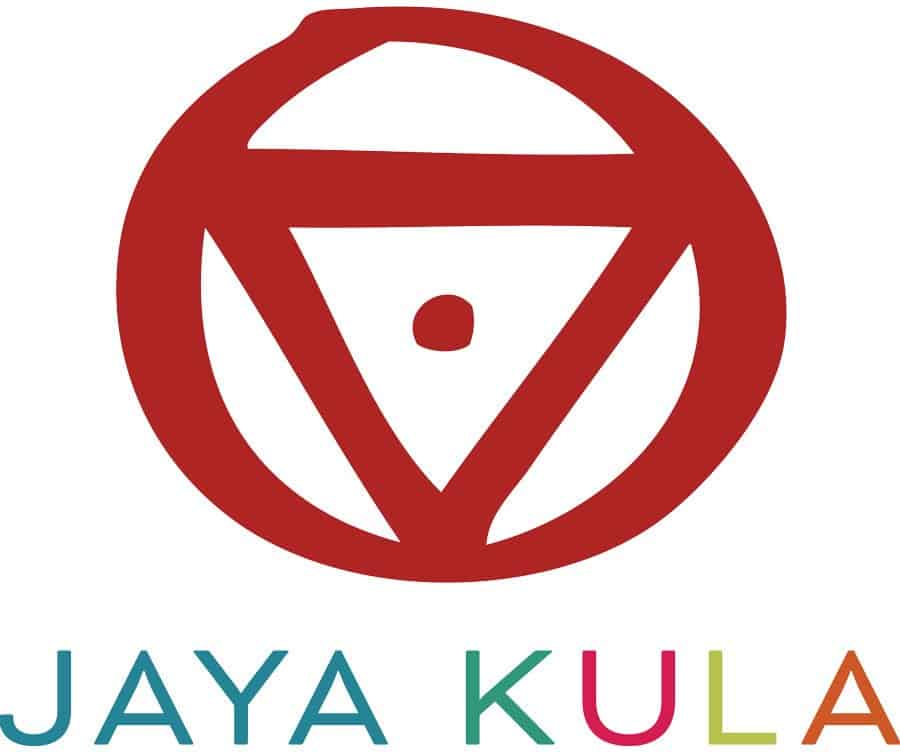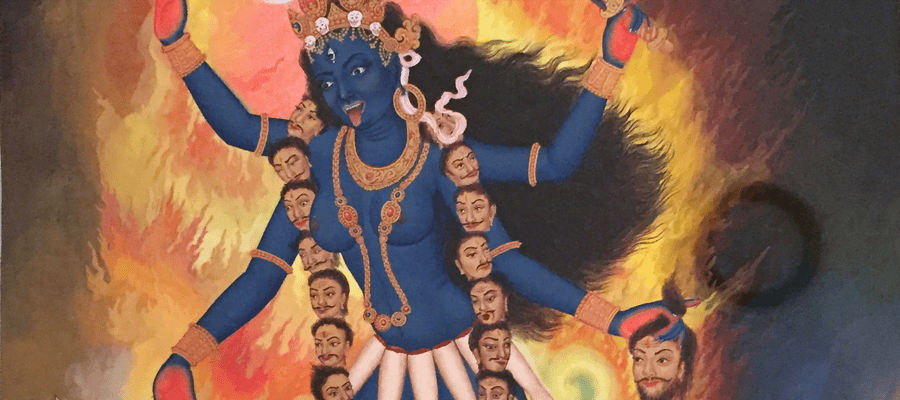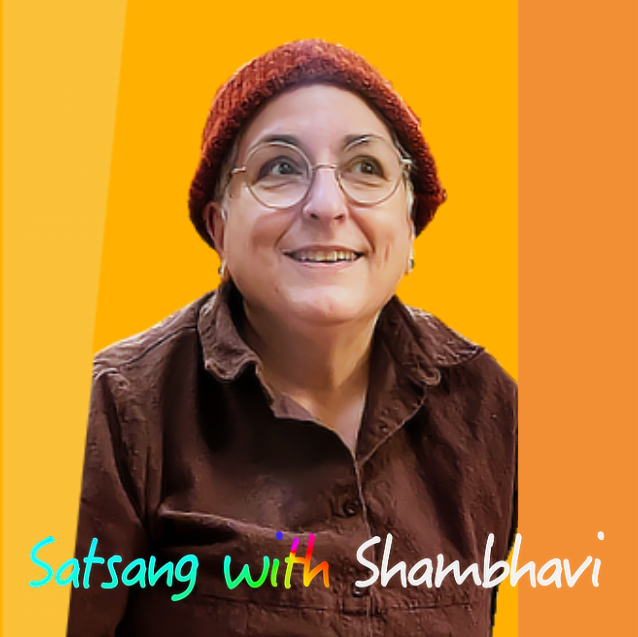Shambhavi and the Jaya Kula community gather for satsang and get real about all the questions we humans want answered. Intimate, courageous, heartfelt spiritual talk about pretty much everything. So happy you are here! A podcast from Satsang with Shambhavi
SHAMBHAVI
Hello, everybody. Welcome. So this is Durga Navaratri. It means the nine nights of the Goddess. And it's a major festival for all over India, but for Shakta traditions in particular, celebrating different forms of devi.
And then there's the 10th day, the day of victory, where we celebrate all the wisdom that we've gained and have puja and a party. So it's really a ten-day festival, and it's celebrated in very different ways and different traditions in different parts of India.
And the way that we celebrated it when I was practicing in a community that did this each year was we would do the first three nights of Durga Navaratri would be Kali puja and Kali sadhana, and then Lakshmi, and then Sarasvati.
So Kali first, because in order to reap the rewards of the full, of our sadhana, we have to have obstructions cleared away first. So that's why the fiercest form of devi is celebrated first or propitiated first.
And then there in some other traditions, they do sadhana and puja to the maha vidyas, those are ten forms of the goddess that are all incarnations of Durga. So Tara is one of those incarnations.
And we're going to be doing Tara mantra tomorrow, not because it's traditional, but simply because she is one of the forms of Durga. And I like doing her practices, [laughter] so I have no other excuse.
So the question is, who is devi? Who is Durga? Who is Shakti? And if we want to know, one of the things that's beautiful about the tradition that we're in is that it consults our own lived experience, first and foremost.
Before concepts, before intellect, before books, before ideas, before rules, before authority of somebody else. We are trained to be looking to our own experience and to be working with that.
So the easiest way to access who is Durga, who is Shakti, who is devi, is to close your eyes just briefly. And experience your body as a shape without any detail. Just a shape sitting on your floor or your cushion or your chair or your bed, wherever you're sitting.
So one shape, one whole experience of your body, and then allow yourself to make contact with the quiet feeling of vitality throughout your body. A quiet hum of life. A quiet vibration in your arms and legs, your fingers and your toes, in your torso, and in your neck and your head.
You can make contact with this feeling of aliveness, this experience of vitality, which can also be experienced as a subtle movement everywhere in your body. You could call this your subtle energy.
And for most of us, you can see how easy that is to make contact with. A lot of people in this culture who didn't grow up with roots in Hinduism might say, oh, I have trouble with the deities. I don't relate to them, or something like that.
But you do relate to your own energy. You do relate to your own vitality. And this quality of livingness is the quality of Durga or the quality of Shakti. The most fundamental form of the goddess that we can get in touch with living in every cell of our body, energy, and mind.
So Shakti is the creative principle. Durga is the creative principle. The principle of power. The principle of making things appear, making things happen. And I'm not going to go into the more esoteric teachings about devi.
But if we look at the major story of Durga that this festival is celebrating, the Chandi Path. The story is that there was a demon or an asura called Mahishasura who was ravaging the earth.
And Shiva and Brahma and Vishnu together could not subdue him. So they took all of their shakti, all of their inherent power that was symbolized by the various implements that they carried, the discus and the conch and the trident.
So basically they externalized all of their power into one form and that was Durga. And they gave Durga all of their weapons because they weren't capable of doing this themselves. And so Durga is called Mahishasura Mardini, the killer of Mahishasura.
And she on her own also couldn't do it. So she was fighting and fighting, but the demon was multiplying itself. Every time Durga killed the demon, it would multiply into hundreds and thousands of other demons.
Just like when we are trying to kill a habit, it just seems to be everywhere. We can't get rid of it. So finally, Durga emitted this very, very concentrated form of her own shakti from her third eye. And this was Kali.
So Kali is like the essence of Shakti. She is also celebrated in the first three days of Durga Navaratri. And she was able to vanquish the demon. So she is the ultimate fierceness that we encounter in our lives.
A lot of people like to say they're Kali worshippers but then if they stub their toe, they're screaming about it. [laughter] Kali is the fiercest of the fierce and is there in the moment when we need to have our ego completely cut.
So that we can surrender and be in life with more openness and less stubbornness and rigidity. And this is very difficult for us. So Kali creates difficulties. But through those difficulties we grow and we're able to come into more wisdom about our real nature.
So this is what we are celebrating the first three days of Navaratri. We're letting ourselves say yes to the process of coming into wisdom, which is a destructive process. Kali, of course, is a destructive force.
But what she's destroying are impediments to waking up and recognizing what's really going on here. So this is why we worship her and propitiate her. We're worshiping that force, that concentrated power.
That is so clear. Clarity is one of the main attributes of devi. She has incredible blazing clarity. In some way we could experience this as discrimination or discernment in our own lives.
When we have real clarity that kind of clarity that comes from inner knowing, that cannot be argued away or bullied away or ignored. When we are experiencing that, we are experiencing an aspect of devi.
And in particular when that clarity has to be expressed in a fierce way, we are experiencing that kind of Durga or Kali energy. When it's very one-pointed and just cuts through whatever needs to be cut through in order to help others and ourselves come to clarity in a situation.
So it's when we have to do the hard thing based on this clarity that cannot be argued away or undermined or dismissed easily. This is also a Kali or a Durga quality in our lives.
So these are just a couple of ways in which we experience this force of shakti, this fierce force of shakti in our own lives. And it's what we are feeling grateful for, particularly on the first three nights of Navaratri.
Feeling grateful for the times when this alive, aware, and very wise reality comes and bangs our door down. And forces us to deal with something that we have been trying to evade or skirt around. Or somehow put off to another day.
And this energy of Kali and Durga is the final fierceness or energy that is going to vanquish our pride. Because asuras, of course, are the pride entities or the emblems of pride. And this is the great impediment in human life, is pride.
So think about this in your life and think about in the next three days contemplating how you might let this more fierce energy in in the form of your own clarity. Or the form of someone else's clarity or circumstances that are asking you to surrender to clarity. Surrender to wisdom.
This is what Mahishasura had to surrender to when Kali came after him with absolute one-pointedness the one-pointed energy of the concentrated shakti of all of reality came bearing down on this poor asura. [laughter]
And he had to submit, he had to be vanquished. And sometimes we need that energy in our lives. So think about celebrating that today and for the next couple of days, meditating on it and letting it into your own life more.
And I think particularly for women, and it's kind of funny because not in all ways, but in some ways we are an embodiment of shakti. Everyone and everything is an embodiment of shakti, but somehow we're supposed to be carrying that energy more fully.
And yet, because of the circumstance that we're in, we often avoid our own clarity because it's inconvenient. Or because it seems dangerous to exercise our own clarity.
But think about how you can let that into your life more and honor that more in your life. Honor your own clarity, no matter how fierce it is, and see if you can slay that demon, too. [laughs] If you'll let yourself. The demon of confusion, is the demon we really want to be slaying.
We've celebrated this Navaratri a lot in our time in Jaya Kula and I know a lot of you have also. So if anybody wants to tell any story or share any reflections on this day, please feel free.
STUDENT 1
I just connected to what you said about getting clarity in the time of confusion. Around this time specifically, I've had that.
SHAMBHAVI
I've talked about it a lot before, how it's sometimes easier for us to remain confused. To sort of hold on to our confusion because clarity seems frightening. The consequences of clarity are frightening. When we do this, we are denying Durga in our lives.
STUDENT 2
I've been reflecting lately about people-pleasing habits, and how that gets in the way of being able to even tell when you have the clarity. Because there's these other kinds of filter or attachments that you have to think through.
SHAMBHAVI
There's people pleasing but there's also violence avoidance. So there could be a little bit of reframing there. Sometimes when we don't meet conventional expectations about how we're supposed to behave in a certain situation, we receive unpleasant pushback that is, you know, somewhat violent.
And not in like, we don't—not getting beat up, I'm not talking about that. But in verbally violent or somehow, right? So think about just a little bit of reframing at times.
To have more clarity about is the people pleasing, what is it for? It's not always for the same thing. And it's not just a psychological issue is what I'm trying to say.
In our culture, the individuals are asked to take much too much responsibility for our responses to things that are actually cultural and systemic. So we have to be more clear about what actually belongs to us.
And what is actually, in a sense an appropriate response to the circumstance that we're in. It's all about clarity tonight, folks. [laughter] You're now tuned in to the Clarity Channel, hosted by Durga and her daughter, Kali. [laughter]
STUDENT 3
When you were telling the story, Shambhavi, I really had this visceral feeling of like the asuras multiplying. And kind of dispersing their energy, and like this chaos. And then on the other side like the condensation and almost like the simplification and how that was overcoming like this whirling kind of chaos.
SHAMBHAVI
And of course, in all of these puranas and all of these teaching stories from India, these battles are really taking place inside of us. I mean, we're meant to enjoy them as great epics and stories of external battles.
But we're also meant to take them as what is happening inside of us when we're trying to grow and defeat our karmas. So we have this capacity for clarity and force and fierceness.
And then we have these asuras and demons that are running around trying to confuse us. And they're trying to stay alive, you know, so they can keep their patterns going.
And of course, if we look at these stories very closely, we can really see our own journey in them. Where we get some clarity and we exercise some force to change certain things about how we're showing up in the world.
And it seems like when we do that, they multiply. It gets harder, not easier, for a little time. And then we have to really get serious about it. [laughs] And finally, the asura is vanquished.
So it really follows the same pattern that we follow in our lives. Sometimes, if you're trying to quit a habit like smoking, the minute you think about quitting smoking, you want to smoke more. [laughter] The habit gets worse. [laughs]
And you really have to concentrate and consolidate and get your mind and body and energy in one direction in order to really put a stop to that.
STUDENT 4
Is it a good time to set sankalpas?
SHAMBHAVI
Well, we don't normally do that. I mean, on this day. I would think if any day it would maybe be the 10th day, but it doesn't really matter. You can take a sankalpa whenever you want.
A sankalpa is like a promise. And the nature of a sankalpa is that you choose something that you can actually accomplish. So a sankalpa should not be, I promise to become totally enlightened. It shouldn't be anything so silly.
It should be something doable that has a kind of a reasonable time frame. So if anyone wants to take a sankalpa, what you do is for women, you tie a raksha bandha on your left wrist and for men on your right wrist.
And usually it's a red thread or a red string. And you wind it once and tie a knot, another time and tie a knot, and another time and tie a knot. So there's three knots and you put mantras into the knot to seal the sankalpa.
So you can use mantras for Durga or Kali, Lakshmi, and Sarasvati if you know them. Or you can use the three mantras we do at the beginning of satsang for Ganesha, Sharada, and Guru, if you don't know the ones for devi.
And then you just cut the string a little short and you whisper also, along with the mantra, you whisper the sankalpa into the knots. So anyone who wants to do that can do that.
Sign up to receive email updates
Enter your name and email address below and I'll send you periodic updates about the podcast.


